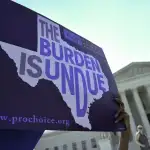The U.S. abortion rate increased in 2020 for the first time in 30 years, according to a triennial survey conducted by the Guttmacher Institute, the premier think tank tracking reproductive health and policy.
The data, which comes from a survey that tracks 1,687 abortion providers and state health department data, suggests a meaningful shift in how many people are choosing to terminate their pregnancies. And it comes just as the Supreme Court looks set to overturn Roe v. Wade, the 1973 case that guaranteed the right to an abortion. Undoing that decision would allow states to ban abortion entirely if they so choose.
“This information coming out just as we’re waiting to see if the U.S. Supreme Court overturns abortion rights is a bit jarring in a sense,” said Elizabeth Nash, who tracks state policy at the Guttmacher Institute and helped write the report. “We are seeing that people need access to abortion care, and they need more access to abortion care, and there’s the potential now for states to ban abortion.”
In 2020, about 1 in 5 pregnancies — 20.6 percent — ended in abortion, compared with 18.4 percent in 2017. For every 1,000 women ages 15 to 44, there were 14.4 abortions, a 7 percent increase from 2017, when 13.5 per 1,000 did so. About 930,160 abortions took place in 2020, the researchers found, compared with 862,320 three years prior. Increases were largest in the West and Midwest and smallest in the Northeast.
-
The latest:
Abortions are still far less common than they were 30 years ago. In 1981, when the U.S. population was significantly smaller, about 1.6 million abortions were recorded, per Guttmacher’s records. That represented a peak, and the number has steadily declined. Since 2011, fewer than a million abortions have been performed per year.
It’s not clear what is behind the 2020 increase. The onset of the COVID-19 pandemic could have discouraged people from giving birth, Nash said. Policies embraced by the Trump administration resulted in fewer clinics providing family planning services for low-income people, which could have resulted in more unintended pregnancies and a greater need for abortions.
-
More abortion coverage
- 37 percent of voters say they will be more motivated to turn out if Roe v. Wade is overturned
- With abortion rights in limbo, conservative lawmakers are eyeing restrictions on IUDs and Plan B
- Many low-income people are already shut out of IVF. Could abortion bans make it even more expensive?
Researchers also pointed to changes in policies that could have made it easier for people to access abortion. Since 2017, 17 states plus the District of Columbia have repealed laws that restricted abortion access. Oregon, Illinois, Rhode Island and Maine all changed their state Medicaid programs so that they now cover the service. (Most state Medicaid plans do not cover abortion, thanks to a law prohibiting the use of federal funds to pay for abortions.) Maine and Virginia both passed laws allowing nurse practitioners and other non-physician clinicians to provide abortions as well. Local and state abortion funds — private organizations that help people pay for abortions — also experienced greater financial support and were able to help more people pay for their abortions, Nash said.
“We’re seeing some trends that possibly are lending themselves to these increased numbers of abortion,” she said. But still, “there’s a lot to investigate about why we are seeing these numbers rise.”
Guttmacher does this comprehensive study every three years and collects less full data for other years. It is too early to say if this trend continued into 2021, or even this year, though Nash said she suspects the abortion rate climbed up until September 2021, when Texas began to enforce its six-week abortion ban. After that, she said, it is harder to make predictions.
States such as Texas, which had already passed heavy abortion restrictions, experienced an increase in abortions from 2017 to 2020 — suggesting that in spite of laws limiting access, more people sought out the procedure.
If Roe is overturned, a number of states are expected to ban abortion entirely. Residents of those states will have to look to other states if they want an abortion and could overwhelm the abortion infrastructure in states like Colorado, Illinois and California, which are projected to become destinations for abortion care. But not everyone will be able to afford to travel hundreds of miles for the medical appointment.
“We are going to see a massive drop in the number of abortions because as much as progressive states are expanding access to care and helping people pay for abortions, not everyone is going to be able to get to those states,” Nash said.








